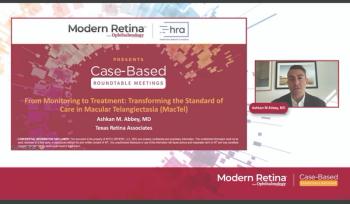
New molecule enhances effect of anti-VEGF therapy for DME
Activation of Tie2–as a result of subcutaneous administration of AKB-9778 (Aerpio Therapeutics) in combination with an anti-vascular endothelial growth factor (anti-VEGF) therapy–enhances the effect of an anti-VEGF drug on diabetic macular edema (DME).
Reviewed by Arshad M. Khanani, MD
Dr. KhananiActivation of Tie2–as a result of subcutaneous administration of AKB-9778 (Aerpio Therapeutics) in combination with an anti-vascular endothelial growth factor (anti-VEGF) therapy–enhances the effect of an anti-VEGF drug on diabetic macular edema (DME).
Based on the results of the Time-2 trial, Tie2 appears to be a beneficial approach for treating diabetic eye disease, according to Arshad M. Khanani, MD.
Tie2 is a transmembrane receptor expressed on vascular endothelial cells. When active, Tie2 plays a role in vascular stability in a number of ways by enhancing endothelial cellular function and viability, maintaining the integrity of the endothelial cellular junctions, inhibiting vascular inflammation, and blocking pathologic vascular leakage and neovascularization.
“The body of evidence supporting the role active Tie2 in maintaining vascular stability is significant,” said Arshad M. Khanani, MD, managing partner, director of clinical research Sierra Eye Associates; clinical associate professor, University of Nevada Reno.
In contrast, inactive Tie2 results in vascular destabilization, which results in vascular leakage and neovascularization, is associated with retinopathies.
In diabetes, angiopoietin (Ang2) and vascular endothelial tyrosine phosphatase (VE-PTP) reduce Tie2 activation in the diabetic vasculature. Alteration of the ratio of Tie2 regulatory mechanisms is a first step in vascular remodeling, which is a common factor in retinopathies, i.e., diabetic retinopathy, DME, wet age-related macular degeneration (AMD), and retinal vein occlusion, Dr. Khanani explained.
AKB-9778 inhibits VE-PTP, the most critical negative regulator and the most downstream inhibitor of Tie2, Dr. Khanani added.
Dr. Khanani and colleagues showed in an in vivo murine experiment that pathologic neovasculature expresses high levels of VE-PTP compared to the normal vasculature. When mice with ischemic retinopathy were treated with a subcutaneous injection of AKB-9778, Tie2 activation in the neovasculature was achieved in contrast to the mice that were treated with vehicle.
Clinical study
The TIME-2 study, a phase 2A randomized clinical trial, tested AKB-9778 alone and in combination with Lucentis (ranibizumab, Genentech Inc.). Dr. Khanani presented the study results on behalf of the TIME-2 Investigators.
A total of 144 patients with DME and a central subfield thickness (CST) of 325 µm or more participated in this study at 36 sites in the United States. The patients received 1 of 3 treatments, i.e., AKB-9778 monotherapy (subcutaneously administered AKB-9778 15 mg 2x daily and a monthly intravitreous sham injection); AKB-9778 and ranibizumab (subcutaneously administered AKB-9778 15 mg 2x daily and a monthly intravitreous injection of 0.3 mg of ranibizumab); or ranibizumab monotherapy (subcutaneously administered placebo injection 2x daily and a monthly intravitreous injection of 0.3 mg ranibizumab).
The patients adhered to this regimen for 3 months and were observed for 2 months. The change in the CST compared with the baseline value was the primary outcome measure.
All patients underwent measurement of the best-corrected visual acuity (BCVA), clinical eye examinations, 7-field fundus photography, fluorescein angiography, physical examinations, measurement of vital signs, laboratory testing, pharmacokinetic assessments, and adverse event reporting.
Important findings
The most important findings in the clinical study were that administration of AKB-9778 plus ranibizumab resulted in a significant reduction of the CST, compared to administration of ranibizumab alone, with a continuing separation of the optical coherence tomography curves at 3 months. More patients who were assigned to AKB-9778 plus ranibizumab achieved a significant reduction in the retinal thickness compared with ranibizumab alone, Dr. Khanani reported.
Specifically, the mean change from the baseline CST after treatment was 6.2 ± 88.4 µm in the AKB-9778 monotherapy group, -109.2 ± 17.2 µm in the ranibizumab monotherapy group, and -163.8 ± 24.3 µm in the AKB-9778 plus ranibizumab group (P = 0.008 compared to ranibizumab monotherapy).
The mean CST at the 3-month time point was 339.9 ± 11.2 µm, with 29.2% of eyes having a CST of 300 µm or less in the AKB-9778 plus ranibizumab group compared with 391.2 ± 17.2 µm, with 17% of eyes having a CST of 300 µm or less in the ranibizumab monotherapy group.
In addition, more patients achieved and maintained dry retinas, that is a CST of 300 µm or less at every time point in the AKB-9778 plus ranibizumab group.
Role in diabetic eyes
“While the benefits in DME are exciting, the results for the treatment of diabetic retinopathy are what could really transform the way we treat diabetic eye disease,” Dr. Khanani said.
In a pre-specified analysis AKB-9778 and ranibizumab monotherapy showed an equal ability to improve underlying diabetic retinopathy in the study eye by 2 or more steps. At 3 months, 10% of patients treated with AKB-9778 monotherapy had an improvement of 2 or more steps in their Early Treatment Diabetic Retinopathy Study Diabetic Retinopathy Severity Scale (DRSS) compared to 8.8% of patients in the ranibizumab monotherapy arm. Over 11% of patients in the combination therapy arm improved by 2 or more steps in DRSS.
Patients also saw improvements in their diabetic retinopathy severity scores in their qualified fellow eyes, 4.2% of the patients who received subcutaneous placebo had a 2-step or better improvement in their fellow eyes compared to 11.4% of patients who received subcutaneous AKB-9778.
No patients experienced serious or severe adverse events related to any of the treatments.
“AKB-9778 has the ability to impact diabetic retinopathy severity,” Dr. Khanani said. “It is a very unique molecule with significant potential to treat diabetic eye disease.”
Arshad M. Khanani, MD
This article was adapted from a presentation Dr. Khanani presented at the 2016 Association for Research in Vision and Ophthalmology meeting. Dr. Khanani has received financial support from Aerpio Therapeutics.
Newsletter
Keep your retina practice on the forefront—subscribe for expert analysis and emerging trends in retinal disease management.












































